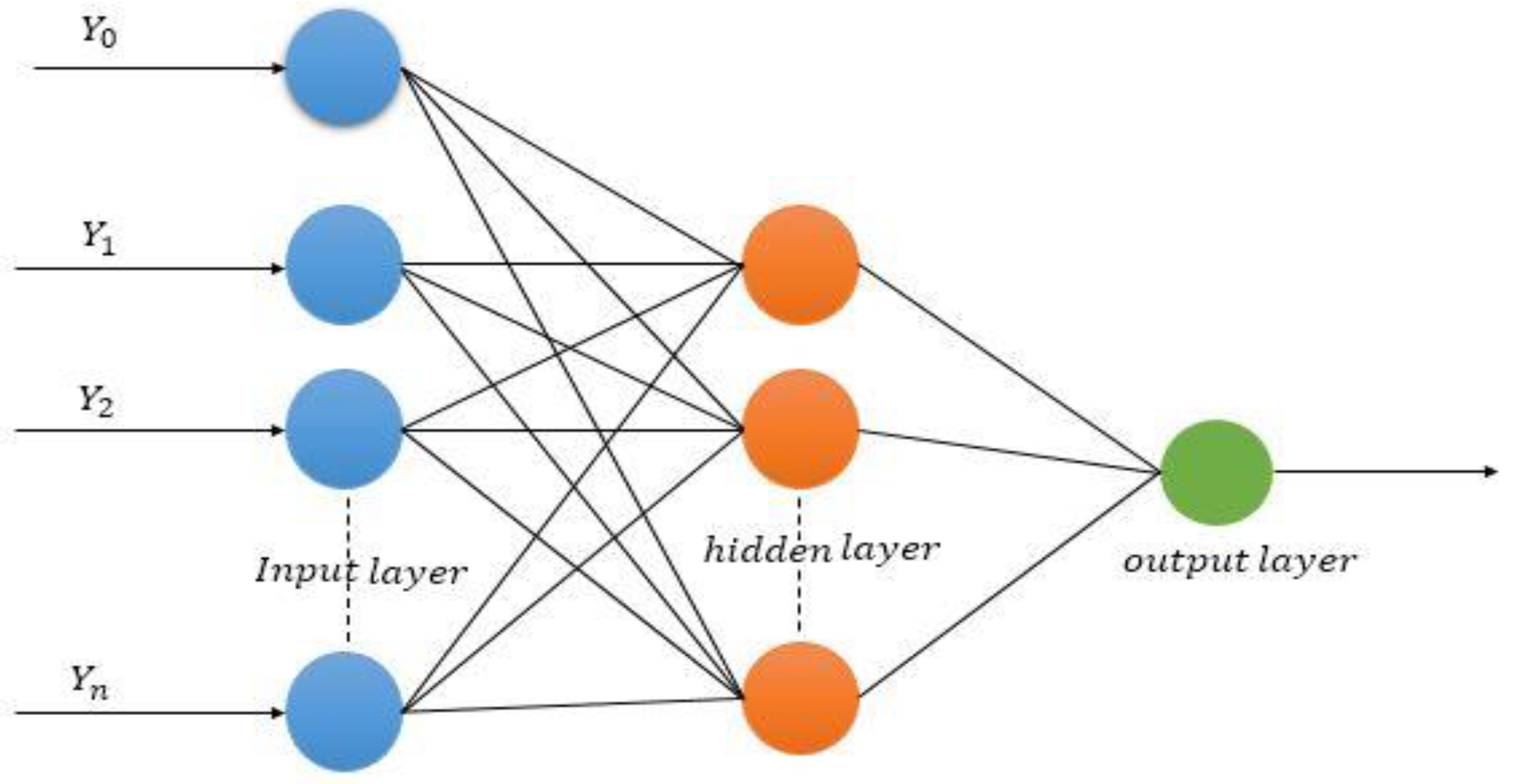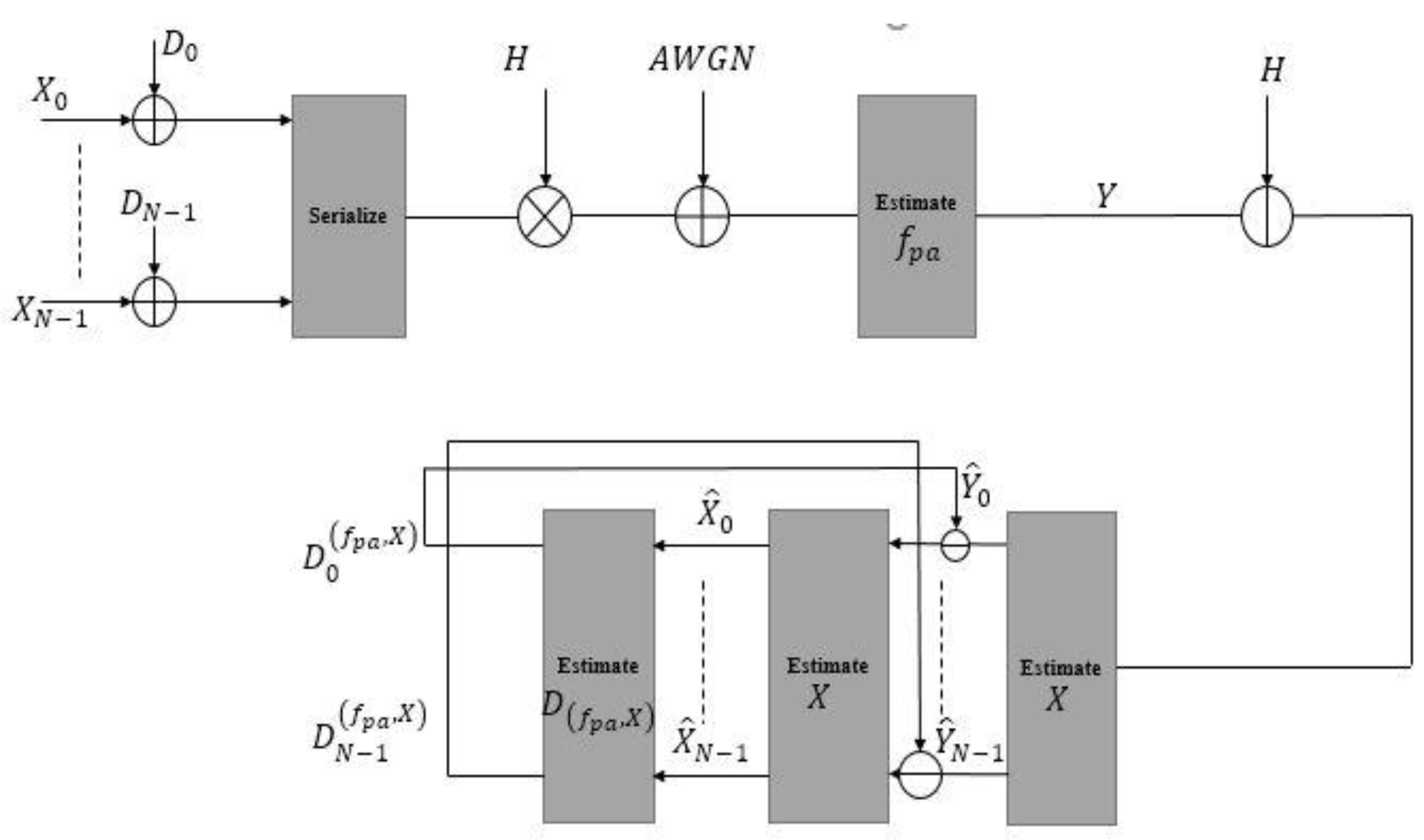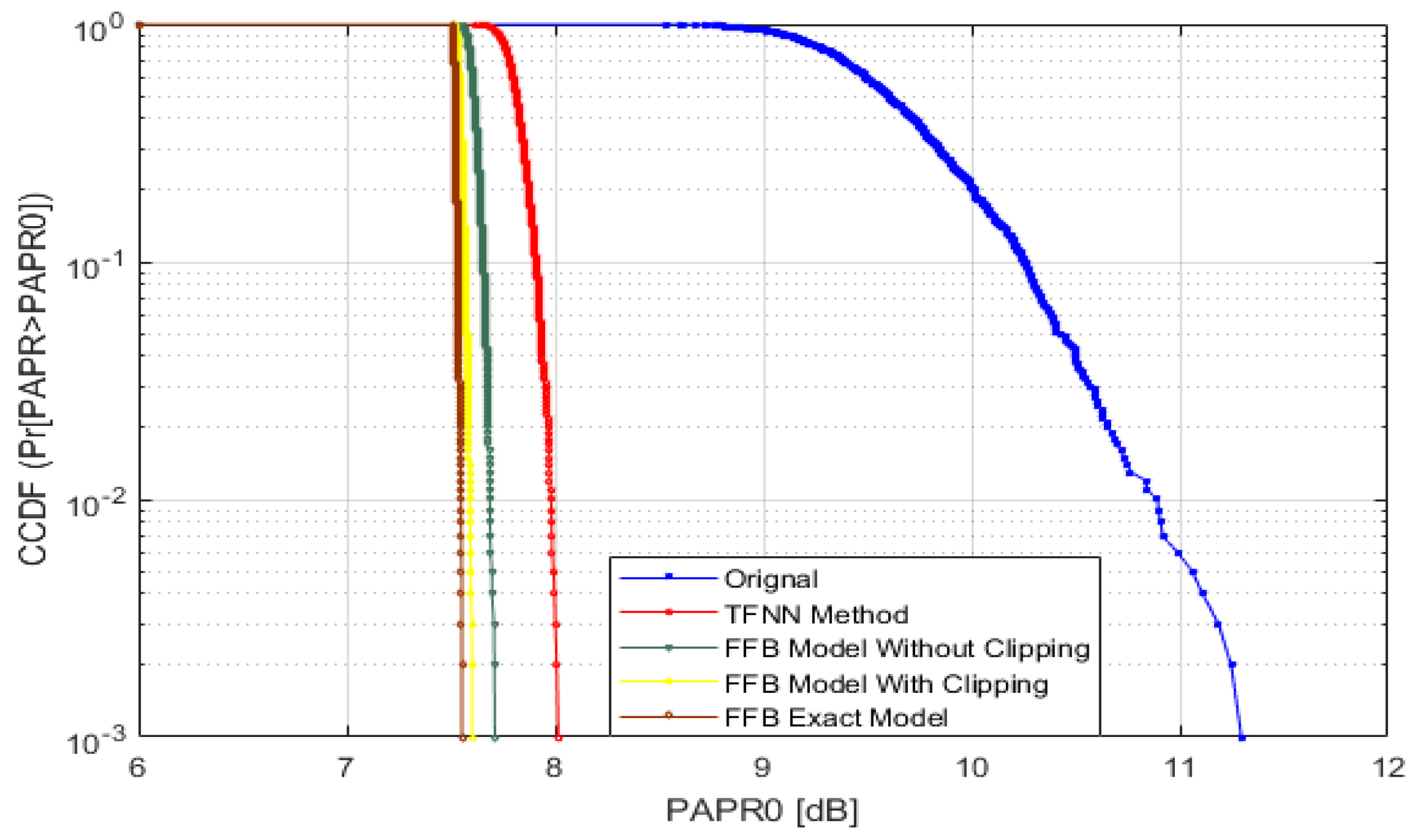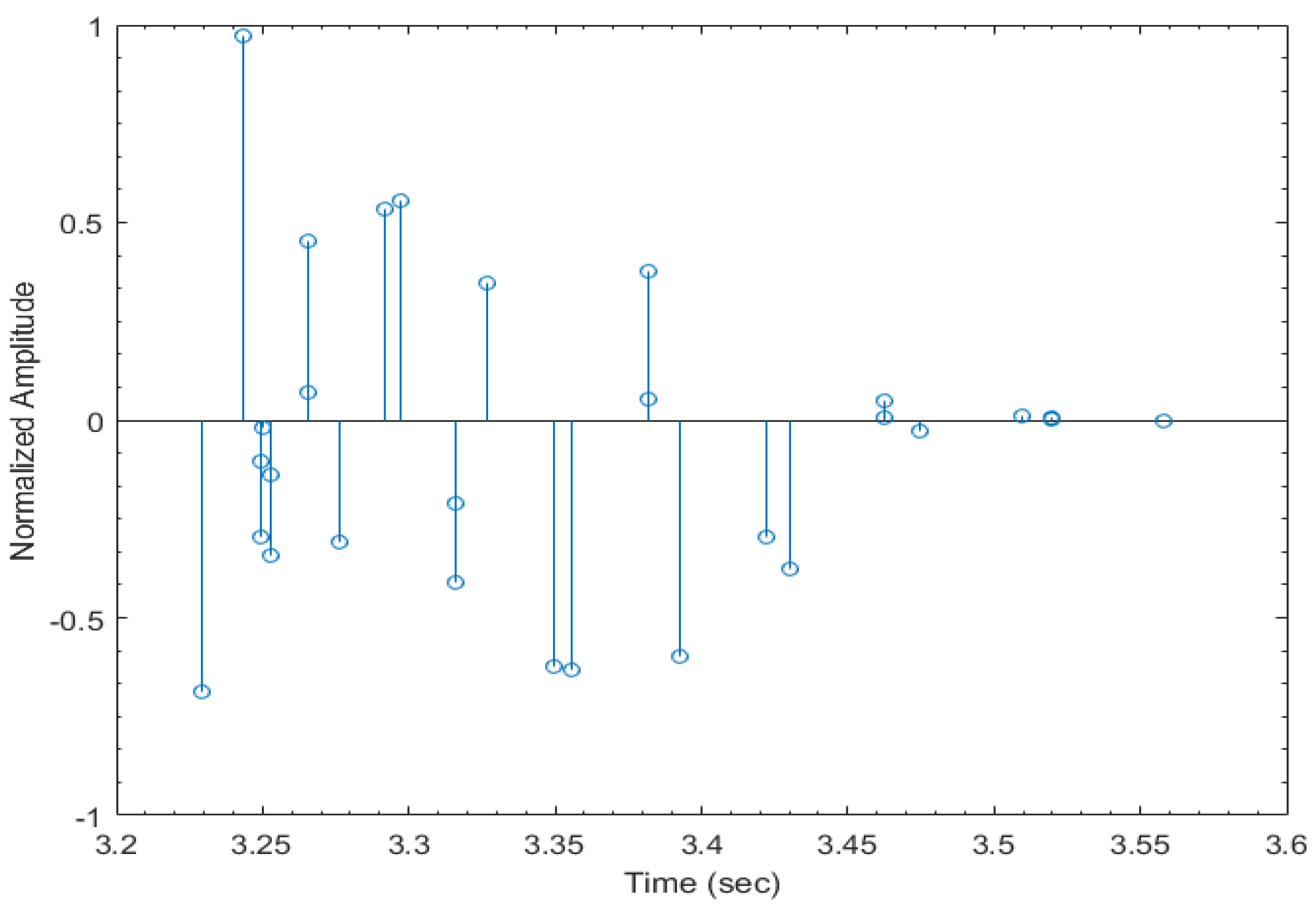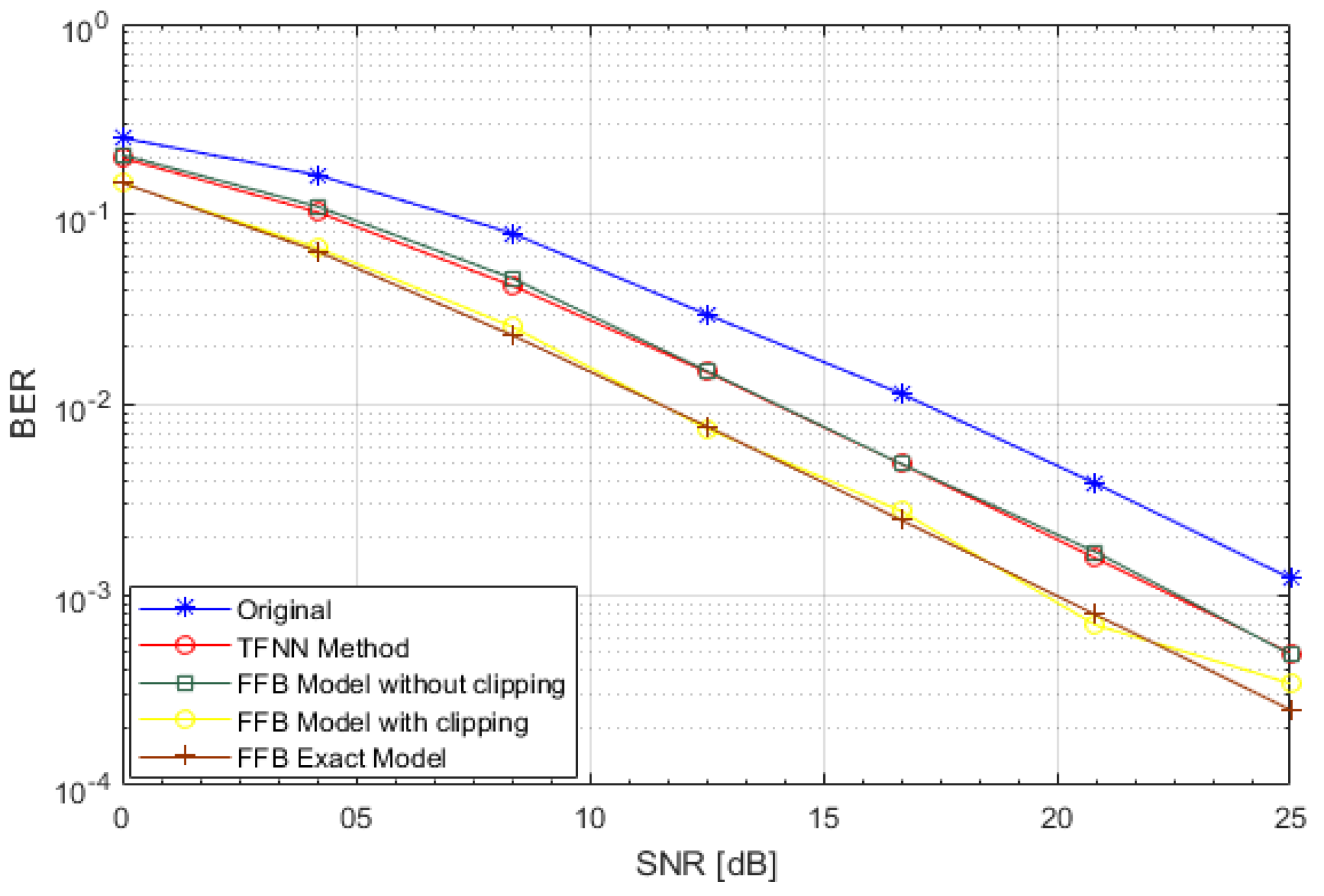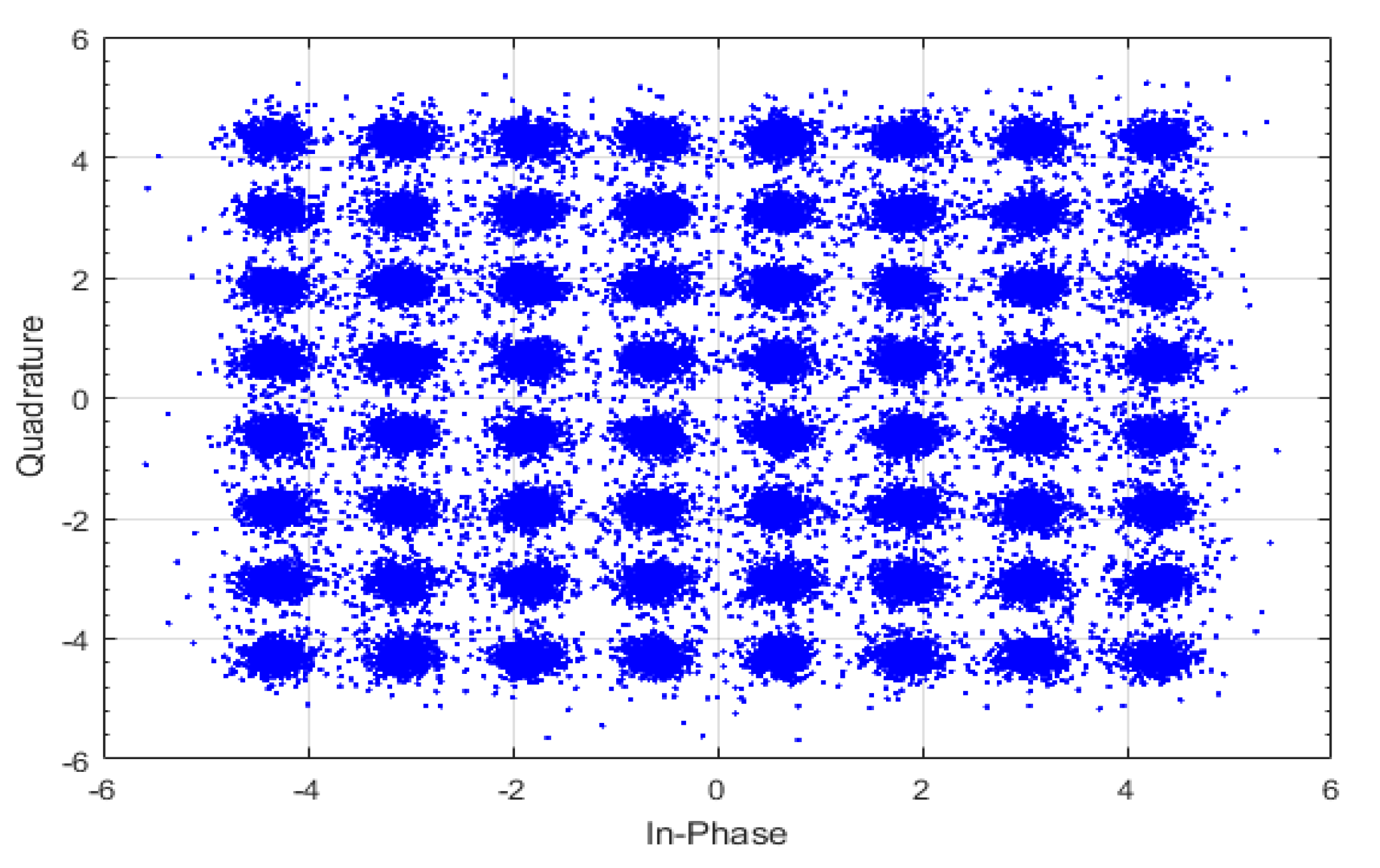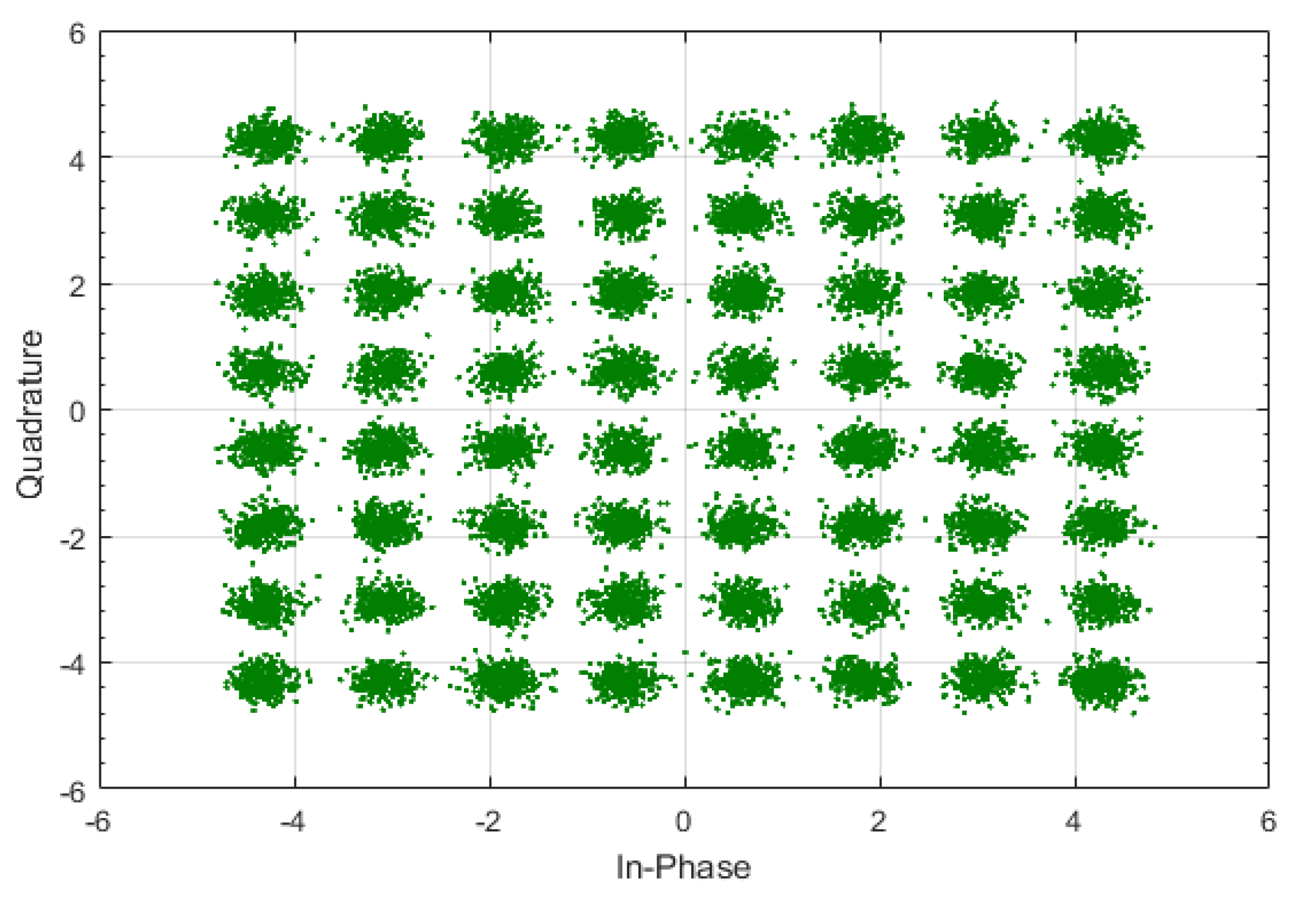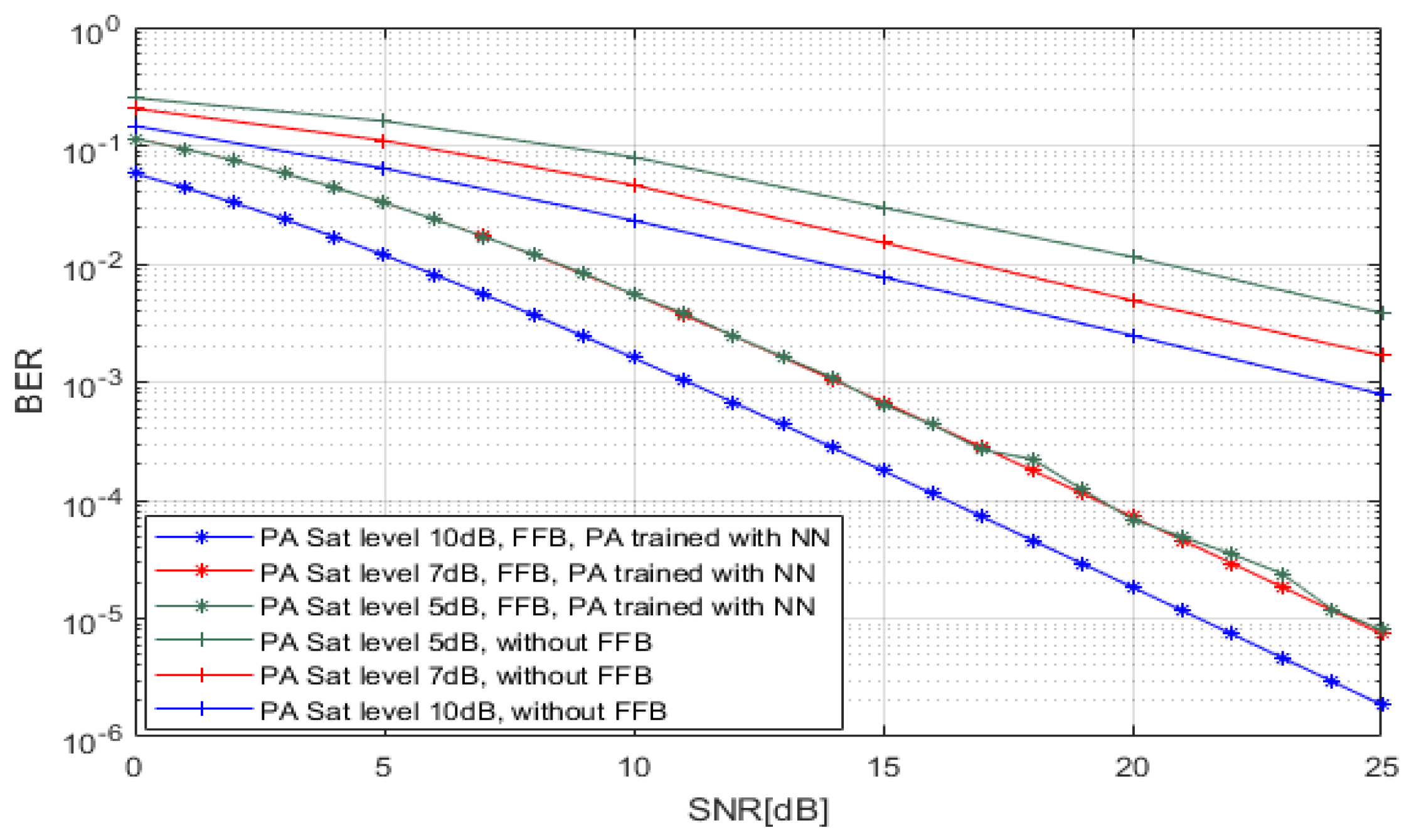1. Introduction
The demand for underwater wireless communication has increased tremendously with expected acceleration in the near future [
1]. The multicarrier modulation techniques have become a hot research area in the last two decades. Orthogonal frequency divisional multiplexing (OFDM) is a multicarrier modulation technique that is popular in underwater acoustic (UWA) communication systems for transferring data [
2]. However, an OFDM communication system has a major lack of high peak to average power ratio (PAPR). This results in lower power efficiency, creating problems while implementing UWA communication [
3]. Besides this, there are several other limitations, such as characteristics of noise, multipath delay, and Doppler shift. These limitations bring great difficulties to the research and implementation of UWA communication [
4,
5]. Energy efficiency matters, particularly in UWA communication, for batteries deployed in underwater acoustic transceivers. Nowadays, a key driving factor is the growing energy cost of network operations, which can make up as much as 50% of the total operational cost [
6]. By increasing the efficiency of a high-power amplifier (HPA), it can reduce energy costs. However, the HPA’s performance is directly linked to the input signal’s PAPR. Particularly in OFDM multicarrier transmissions, which are applied in many important wireless standards such as the Long-Term Evolution Advanced (LTE-A) Third Generation Partnership Project (3GPP) [
7,
8], the PAPR problem still prevents the adoption of OFDM in the uplink of mobile communication standards. It also affects the output power in the downlink coverage. It is necessary to find different methods to reduce the PAPR to a lesser value for a more powerful HPA, resulting in longer battery life and better efficiency [
9]. For underwater acoustic sensing networks, there is the deployment of battery-powered modems in the water [
4]. To maintain a sustainable network operation, it is necessary to reduce the PAPR of the OFDM signal [
8]. For many applications, the problem of the PAPR can outweigh all the potential advantages of the OFDM communication system [
10]. A variety of promising methods for the reduction of the PAPR has been proposed in the literature at the cost of BER, increment in transmission signal power, and computational complexity of the overall system. Therefore, in this paper, the PAPR of the underwater acoustic OFDM system is researched to design a nonlinear PA model with the help of a deep learning algorithm. Finally, we propose a receiver-based nonlinearity distortion mitigation method when the transmitting side has enough computation power. A nonlinear PA model is projected with the help of a modern deep learning algorithm; we call it FFB (frequentative decision feedback).
Related Work
Several pieces of literature have proposed a machine learning algorithm for the mitigation of the PAPR [
4,
11,
12,
13]. Before this study, we will discuss the nonlinearity reduction technique, which resulted in PAs. The first one is a PA with memoryless nonlinearity; the most common method used in this nonlinear PA model is the solid-state power amplifier (SSPA), soft limiter (SL), and traveling wave tube (TWT). For nonlinearity reduction, another PA model with memory nonlinearity is used, which is described in the literature [
14,
15,
16,
17,
18].
The digital predistortion (DPD) algorithm is used in current telecommunication networks for the mitigation of PAPRs. A tremendous amount of research has been presented about the DPD. It deforms the signal before it goes to the PA in a way that the nonlinearity is reversed. It solves the problem of information loss due to nonlinear amplification in the PA. Hence, it is regarded as an adaptive and iterative process, which means the signal input and time will change its coefficients of DPD filters [
19]. Thus, taking the inverse function of the PA input and output characteristics, an ideal predistorter can be formed. A large back-off is needed to resolve the nonlinearity problem; in other words, PBO (peak back-off) [
20]. It is the difference in the power (dB) between the max desired output and the power of PA saturation. This makes a forceful operation by making the PA linear because the input passes through the nonlinear region of its characteristics and then the input power of the signal is reduced. When the value of the PBO is higher, it results in a higher BER and less efficiency.
Among all linearization methods, the DPD is the only choice selected by the industry. The DPD algorithm is briefly explained in [
21,
22]. In [
7], the authors evaluated the performance of OFDM modulated symbols in a frequency-selective fading channel. The authors utilized a traveling wave tube (TWT) model of the PA in the article [
23]. To reduce the nonlinearity, the authors presented novel research in the literature [
24]—the signal constellation based on active constellation extension (ACE) built with a neural network termed time-frequency neural network (TFNN) is estimated. In this method, the time and frequency domain are considered simultaneously. The clipping technique is used to reduce the magnitude in the time domain. Furthermore, for the frequency domain, the constellation movement is restricted to only a few reasonable values. This model separates the real and complex parts of the symbols. The two neural networks are formed as
and
. The authors used the maximum likelihood method to detect the distorted symbols at the receiver. The autoencoder scheme for the reduction of the PAPR in the literature [
25] uses the autoencoder of deep learning termed PRNet. The PRNet method performs well in both PAPR and BER at the cost of computational complexity. The deep neural network-based OFDM receiver has been proposed in the literature [
26,
27] for UWA communication. The authors used a single neural network to implement aggregate signal processing. This method was tested by using a ray-tracing toolbox with a sound speed profile (SSP) measured in a real sea experiment. In the research [
28], the authors adopted adaptive modulation for reducing the filter concatenation effect for optical OFDM communication. The transmission performance was improved by up to 60%. Four types of optical filters, including fiber Bragg grating (FBG), wavelength-selective switch (WSS), thin film, and Chebyshev, were used to evaluate system’s performance. The power loading (PL), bit loading, and bit-and-power (BPL) loading algorithms were introduced in the literature [
29] by over 1000 statistically constructed worst-case multimode fiber (MMF) links without incorporating inline optical amplification. The authors proposed compressed sensing (CS) in [
30,
31,
32] for mitigation of clipping noise in UWA communication. This scheme exploited pilot tones and data tones instead of reserved tones which is different from traditional clipping methods. It provides more accurate UWA channel characteristics for estimating the clipping noise than traditional methods such as Least square (LS) and measuring mean squared error (MMSE).
The proposed algorithm is named FFB, which detects nonlinear distortion at the receiver side. Our method is based on research [
14]. The method used in [
33] is an extension approach of the literature [
14]. The proposed PA model is called a memory device whose output depends upon the OFDM symbols. The channel estimation was performed using pilot symbols. In this process, only a few carriers were active. It makes sure that the value of the PAPR is low, and the PA mostly operates in a linear region. In this paper, we have used the approach used in [
14]; we named this method FFB. The FFB model is used to mitigate the nonlinearity of the PAPR. Firstly, the PAPR is reduced in an OFDM system with a clipping technique. Secondly, the unnecessary distortion caused by high PAPRs is reduced at the receiver side by using a modern neural network. This model is trained with a machine learning algorithm with a proper set of data. Collectively, the channel coefficient fits best to the maximum likelihood model, and the performance is improved in terms of the BER and higher efficiency.
2. System Model
In this section, we discuss the effect of the PAPR in OFDM modulated signals, and how it affects the communication system and the BER and degrades performance. The lower-case
is used for time-domain values, and for frequency-domain values, we use
upper-case values. Furthermore, the complex conjugate of
is denoted by
. The vectors are represented as boldface or sequence
x[
n], e.g.,
. The frequency is denoted as
, and index n stands for time. In order to better understand the PAPR, the OFDM-modulated symbols were analyzed more deeply. We consider the quadrature amplitude modulation (QAM) symbols
; these are modulated over subcarriers
. Each of the QAM has maximum amplitude as
, separated by a bandwidth B of Hz or a duration of
seconds. Each OFDM symbol comprises of N, equally spaced QAM symbols. It can be written mathematically as
The OFDM symbol index is denoted by p;
represents the QAM value of
subsymbol. To avoid the intersymbol interference (ISI) and make channel flat fading in each subcarrier, the CP cyclic prefix is added; the length of the CP is greater than the delay spread of the channel. Some part of the signal
is copied from the end, and we add it to the front of the transmit signal. Hence, the signal transmitted with a cyclic prefix can be represented by Equation (2).
where the last L symbols are added together in a series at the front of the OFDM symbol block. The IFFT is used to generate
. Before the IFFT operation, the signal is converted from serial to parallel, then it is upsampled by a factor L. Upsampling can be regarded as one way of pulse shaping in an OFDM. After these two operations of upsampling and IFFT, the transmitted digital signal can be represented as
where
is L times the oversampled QAM vector. Hence, the transmitted symbols are
, which are the IFFT of the upsampled QAM symbols
.
2.1. PAPR
Let us calculate the average power of OFDM symbols and derive a mathematical relationship between the PAPR and OFDM number of subcarriers in this subsection. Firstly, the average of OFDM symbols is calculated. The PAPR can be defined as the ratio of max (transmitted signal)/average transmitted power. It can be written as
Here is the average signal power.
The average signal power is evaluated further as =
Since
is a phase factor, if it is equal to 1, also
, then
Thus, the average power of transmission is
. To analyze the peak power when QAM symbols have an amplitude of
, we consider all the information symbols of QAM as
, which has an amplitude of
Hence, we see that the peak power is . The ratio of peak to average power (PAPR) . N is the number of subcarriers, which can be 32, 64, 128, 256, or more than 512. In conclusion, the PAPR in an OFDM system is high when the number of subcarriers increases by order because the symbols of data in the subcarriers are added up, which produces the high peak valued signals. The signal which passes through a PA or transmitting transducer can be split into two different components. The first one is a distorted part, and the second is with no distortion. By doing this, we have an opportunity to estimate the distorted part of the signal at the receiver side. If the model of the PA is known, then the distortion term can be estimated efficiently. Therefore, the machine learning algorithm can help us to assess the PA model at the receiving side. The performance and computational capabilities of this algorithm are very high, and it can estimate accurately. Hence, this allows us to design a signal processing algorithm that will estimate the distortion term and give us improved performance.
2.2. Clipping
Before amplification through the PA, the signal is clipped as per saturation levels of the PA. The operation of clipping is defined mathematically as
The system model shown in
Figure 1 is explained mathematically in the above equations. Here,
represents the clipped signal for the
OFDM signal; "A" determines the level of clipping amplitude level. Clipping is the most basic reduction technique for reducing PAPRs. However, it has a major drawback of in-band and out-band distortion, which causes the performance of the BER in the overall system. When we clip the input signal to the PA, we should make sure that the signal is passing through a linear amplification region so that PAPR performance is improved.
2.3. OFDM Receiver Model
The receiver block comprises the learning PA model, removal of cyclic prefix, then the use of FFT for demodulating the symbols, which is followed by channel equalization. During the start of communication, learning the PA model is necessary. The learned PA model should be updated at some specific intervals. In this work, we have not studied the time frames when the PA model should relearn; it is an optimization proposal. The learning PA model depends upon the frame time, call duration and data rate. The next segment in the receiver model is a distortion-removal block, as shown in
Figure 2. In this portion, we used a signal processing algorithm for distortion removal, which is caused by the PAPR. After distortion removal, the parallel stream of the signal is obtained before being downsampled by factor L. The last part describes the unmapping or demodulation of the QAM symbols.
2.4. Learning the Power Amplifier with Neural Network
In this article, firstly, we conducted research to reduce the PAPR in underwater acoustic OFDM communication. Secondly, unnecessary distortion, which is caused by high PAPR, was reduced at the receiver. It affects the BER performance of the overall system; for this, we need to learn the PA model at the receiver. To learn a model we need to train the Machine learning algorithm with a proper set of data. At the beginning of this communication, a set of QAM symbols is generated by the transmitting transducer with different amplitudes over the range of PA characteristics. The data are transmitted through a noisy underwater acoustic BELLHOP Gaussian beam tracking model with several delays and multipath effects. The PA machine learning model at the receiver side is explicated in
Figure 2. Hence, at the receiver’s data acquisition, this model is used. If there are better and more appropriate data sets, one can use various deep learning algorithms and train the model before using this distortion mitigation process. Here, we have implemented a neural network (nonparametric) model.
The neural networks are being classified under the nonparametric models. The weight of the hidden neurons that is learned does not provide physical meaning for the undergoing consideration of the problem. The main aim of training a neural network is to estimate the whole function, not only approximating the weights (as in the parametric model). The proposed distortion algorithm demands the knowledge of the PA model at the transmitter side. In this paper, we implement a feed-forward machine learning (neural network) method that estimates the PA characteristics model at the receiver side. A neural network has the advantage of using the method as a universal appropriator. It can realize an arbitrary mapping of a single vector space onto different vector spaces. The training process is regarded as the leaning of weights; supervised and unsupervised are the two types of training processes. The supervised training process is used when the NN knows the output, and it adjusts the weights accordingly. An example is a feed-forward network. In the unsupervised training process, the NN does not know about the output; it recognizes a random pattern and develops a certain relationship. The multilayer feed-forward neural network (MLFNN) is used in this article as we know about the desired output values. Hence, it is the correct decision.
The neurons are ordered as input, hidden, and output layers in a MLFNN, as shown in
Figure 3. In each layer, the neurons relate to another neuron in the upcoming layer. There is a connection between
and
neuron, which is characterized by
and threshold coefficients of
and
, as described in
Figure 4. The importance of the neuron is represented by weights that have a connection in the model. We can calculate the outvalue of the neuron as
In Equation (12),
denotes the potential of the
neuron function
or the transfer function. The transfer function is applied to all neurons
, the transferring signal to the
neuron. The threshold coefficient is the weight coefficient of the connection between i neuron, where
yi = 1; it is called bias. Then this transfer function can be a sigmoid, defining a nonlinear solution.
The threshold
and weight
coefficients are changed to reduce the sum of the square difference between the actual and desired outputs. After this, the minimum cost function can be written as
The desired output and actual output runs overall j are denoted by vector and . There is a different training algorithm described for calculating the weight and threshold values in different researches. The most common algorithm is the backpropagation algorithm.
3. Frequentative Decision Feedback (FFB)
In this section, an iterative feedback system is used to remove the distortion in the overall system. It is assumed that the nonlinearity caused by the transmitting side will be mitigated at the receiving side.
Figure 5 shows the FFB model used in this paper. If the nonlinearity is present in the discrete time domain, then this analysis provides authentic results. When there is nonlinearity in the continuous time domain, then it gives us approximate results. It can be more accurate when oversampling takes care of the spectral regrowth.
where
xn represents the input to a PA,
fpa is the learned model for the PA, and oversampling is given as
L. The output can be expressed as a linear combination of actual amplified input to the PA and a distortion term. MSE
is minimized when we put the value of the constant
α in such a manner. The variable contains some distorted energy that is not related to
. The soft limiter and SSPA nonlinearity are proved
by putting the value of clipping > 7.3 dB. If the intersymbol interference (ISI) of the channel is less than the value of the cyclic prefix (CP), then it is shortened to a single multicarrier symbol. After this, the distortion looks like the deterministic function of
, so
. Hence, the QAM vector will have the
symbol and
, which will contain the nonlinearity distortion. The FFT can be computed from Equation (16) over the whole interval, which also includes the oversampling discrete interval. Mathematically it is written as follows:
The time index here is K. Then, we can expand Equation (17) further as
Here,
is the out-of-band distortion; thus, to minimize this distortion, we use clipping and windowing. The symbol index p will be eliminated with oversampling
L for the receiver design to be explained more clearly, which makes equation representation simpler. Furthermore, an assumption takes place before applying a reduction algorithm; the out-of-band distortion is minimized. If
is the FFT of the channel impulse response
h[
n], then, in this regard, the received symbols can be represented as
where
is the Additive white guassian noise (AWGN) component for the
OFDM symbol. A maximum-likelihood receiver for estimating
will be
While considering one OFDM symbol, Equation (19) can be written as a vector form.
is the transmit symbol vector.
The element-to-element vector product is denoted by ×. Replacing the value of
from Equation (18), we can write Equation (20) as
If we solve Equation (21) directly for
, it will lead to exponential complexity as we know
and
are complex nonlinear functions. Hence, to get the solution, the term
will not be computed; instead, we assume
, which is not related to X, and it is approximated as an AWGN. Thus, we can write mathematically for
N independent subchannels after reducing an ISI channel
where
If the receiver computes the value of
, the maximum-likelihood problem of Equation (21) will be simplified as
From the Equations (22), (23), and (24), regarding computation and complexity, we can deduce the problem as a standard linear solution maximum likelihood decoder. When the transmission is uncoded, the problem of a vector into different N scalar maximum likelihood equations can be reduced as
or it can be written as
If the value is known to the receiver, it will select the symbol which is close to . At the same time, the new system is introduced here with less complexity, and the distortion is reduced.
In Algorithm 1, if the receiver knows the nonlinear PA function
, then this algorithm can iteratively approximate the distortion term from the received vector
, and it can estimate the QAM vector. This is assuming that the information about the channel and the PA nonlinear model is perfectly known at the receiver. Then, this algorithm can be easily implemented in a few basic steps, as can be seen from Algorithm 1.
| Algorithm 1. Frequentative Decision Feedback (FFB). |
| 1: Need: Received OFDM symbol blocks |
| 2: Make Sure: The Channel impulse response is known at the receiver |
| 3: Make Sure: The PA nonlinear model should be estimated using Machine Learning |
| 4: Procedure Distortion Based Reduction Algorithm |
| 5: For i do number of OFDM symbols |
| 6: removed cyclic prefix from |
7: for j do number of frequentative feedbacks
the estimated OFDM symbols, is the distortion, |
| 8: |
| 9: |
| 10: |
| 11: |
| 12: |
| 13: |
| 14: end for return |
| 15: end for |
| 16: end procedure |


